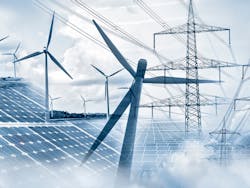Biden administration marries transmission and microgrid funding in $2.5 billion program
The Biden administration yesterday took the first step to allot $2.5 billion to increase transmission capacity and build microgrids in certain locations.
With the release of a request for information, the administration kicked off a process to fund new or improved transmission line projects that offer 500 MW to 1,000 MW of capacity and build microgrids in Alaska, Hawaii or US territories.
The money comes from the $1 trillion Infrastructure Investment and Jobs Act signed into law by President Joe Biden in November 2021.
Called the Transmission Facilitation Program, the new initiative is designed to ensure electric reliability as the grid transforms, moving more renewable energy long distances and handling increased demand from electric vehicle charging.
The Department of Energy (DOE) issued yesterday’s request to collect information from stakeholders in preparation to offer funding later this year.
The money will flow from the DOE in three ways: loans, public-private partnerships and capacity contracts.
For the capacity contracts, the federal government will act as an anchor customer to help de-risk the investment for private players. The DOE could secure up to 50% of the capacity in a project and hold it for 40 years or until the project garners enough subscribers to stand on its own financially. In doing so, the federal agency hopes to create a degree of investment certainty for developers, operators and marketers.
The first solicitation will be confined to projects eligible for capacity contracts and that can begin operating no later than Dec. 31, 2027. The agency is planning a second solicitation in early 2023.
Preference will go to projects that improve resilience and reliability, facilitate interregional transfer of electricity, lower greenhouse gas emissions and use technology that enhances the capacity, efficiency, resilience or reliability of the transmission system.
Learn more about available microgrid funding from the DOE at Microgrid 2022, June 1-2, in Philadelphia, Pennsylvania.
Microgrids will be eligible for funds if they connect to existing transmission, transportation or telecommunications infrastructure in the designated states and territories.
In the request for information, the DOE asks for input on which of the forms of funding — capacity contracts, loans or public-private partnerships — would be most useful for microgrids.
The DOE also seeks input on how to evaluate a microgrid project.
Transmission line projects often face opposition from property owners, delaying construction for years or even killing projects. This problem has become one argument in favor of more microgrids. In the request for information, the DOE says “community engagement” will be central to the phases of the projects.
“Expanding and strengthening our power grid means we can get Americans power where and when they need it most, and in so doing deploy the clean energy we need to reach our climate goals and ultimately bring down energy costs,” said US Energy Secretary Jennifer Granholm. “With nearly 70% of the nation’s grid more than 25 years old, the president’s Bipartisan Infrastructure Law is a pivotal catalyst for transmission projects across the nation that will deliver good-paying jobs in the process.”
The request for information is available on the DOE’s website. Comments can be submitted at the federal government’s regulations portal. Questions can be sent to [email protected].
A public webinar will be held on May 26.
Track news about microgrid funding. Subscribe to the free Microgrid Knowledge Newsletter.







